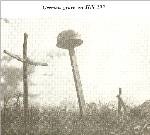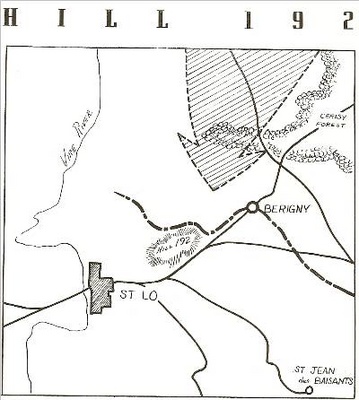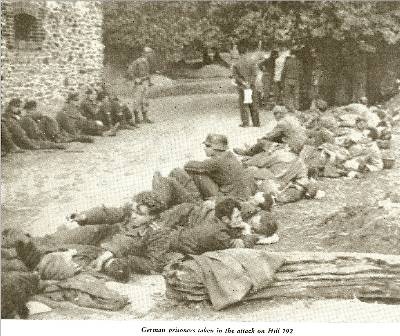 Out of reserve and back to positions around La Griffardiere and Le Parc the battalion moved; improvement of defensive positions continued and reconnaissance and combat patrols resumed. Hill 192 looked own on the men, a constant challenge; the first attempt to take it had failed. And the second? The importance of taking his hill can hardly be overestimated.
Out of reserve and back to positions around La Griffardiere and Le Parc the battalion moved; improvement of defensive positions continued and reconnaissance and combat patrols resumed. Hill 192 looked own on the men, a constant challenge; the first attempt to take it had failed. And the second? The importance of taking his hill can hardly be overestimated.
It dominated the commanding ground overlooking St. Lo, pivotal hinge upon which rested the German network of defenses of the beaches and it marked the end of the detested hedgerow fighting country, in which tanks were partially immobilized, and every field a natural for defense.
Take St. Lo, General Patton is reported to have said, and we will be in Paris within two weeks.
Yes, take St. Lo, and anything could happen and history has proven anything did.

The real war of nerves against Hill 192 began 5 July, when Regiment approved a supported raid. Details of the raid as worked out by Battalion were as follows.
a. The raiding party to move under cover of darkness to a LD in Company E’s front line.
b. To cover advance of raiding party to objective by intense artillery, mortar, and overhead machine gun fire.
c. On signal from a signal lamp to shift covering fires from objective so as to box in and isolate hedgerow under assault.
d. Raiding party then to place demolition charges on enemy positions, cross defended hedgerow, kill and capture as many enemy as possible, and then return to our lines on whistle signal of raid leader.
The purpose of the raid was five fold:
a. To cause enemy to reveal his defensive fire plan
b. To demoralize and soften up enemy in our front.
c. To determine exact knowledge of enemy defensive strength and organization in our front.
d. To capture prisoners for identification.
The raiding party was headed by Lt’s Winstead and Susser. The combat groups consisted of S/Sgt Bennett, Sgts Humphries and Martinez, PFC’s Smith and Carter, Pvts Ramirez, Rath, Randolph and Nathan; support group had PFC Howell and Pvt Basile. In the demolitions team were Sgt King and Pfc’s Louie and Irwin.
The planned artillery, mortar, and machine gun fire for the raid bean directly at 2300 hours. At 2305 the patrol had reached the assault position and had set off a bangolore and one satchel charge, a second later the second satchel charges was set off. Y 2328 hours, the patrol was reporting in with these excellent results:
a. Discovery of two mortar positions.
b. Positions of machine guns from which fire was received.
c. Told of alert enemy fire with automatic weapons.
d. Reported artillery fire delivered on signal of red and green flares.
e. Recorded emplacements of enemy dug in close to hedgerows with openings for fire, the majority sodded over.
f. No prisoners of war were taken, but estimated enemy strength at two squads.
g. Set enemy casualties at eleven dead or seriously wounded.
Our casualties were one seriously wounded and 2 slightly wounded. Pvt Roth the seriously wounded man spent the night in custody of the Krauts, but was returned to our medics the following morning.
All who participated in the raid received an award of the Silver or the Bronze Star for gallantry in action.
The above facts tell the story in a way, but there is much more to it. PFC Louie could have told you what an eerie feeling it is to creer up in pitch black darkness to the enemy lines, fearfully holding your breath, knowing how the slightest noise, a twig snapping, might mean disaster. And then to reach your destination, a hedgerow behind which an alert enemy lurked, his machine guns blazing away, making angry and deadly sparks in the night. PFC Louie said that when he raised himself up alongside the hedge his feet were literally straddling a machine gun, the bullets zipping between his legs. Then he calmly – his heart beating in his mouth – raised his satchel charge and dropped in directly over the hedge on both the gun and crew. The second of waiting, when he huddled close to the ground, was an eternity. Then the charge went off; screams pursued him as he hastened back. The gun was silent.
The next few days that followed saw no outward change in the situation. But each day, supplies were being moved up in increasing numbers, artillery set up and tanks maneuvered where they could take advantage when the breakthrough chance came. On July 8 the orders came down for the grand assault on Hill 192 which was to mean the ultimate capture of St. Lo.
The battled that followed was one of the most carefully planned, the most thoroughly coordinated, and the most excellently planned in the war. It will be used in the future as a model of infantry-tank-artillery coordination, and for years henceforth, officers will study the actions as we performed them on that memorable day. For this reason, the author has attempted to give you as detailed and comprehensive a report of the operations as he could.
The objectives of the assault were Hills 192 and 147. This was the high ground which dominated the approach to St. Lo. The intelligence report of the enemy situation follows. Enemy troops to the front were elements of the Second battalion, 5th Para Regiment and the 3rd Battalion, 9th Para Regiment, both part of the 3rd Parachute Division. In addition to the usual 8cm, 10cm, and 12cm mortars, there was estimated to be in support; one propelled 88mm guns firing from alternate firing positions, and possible additional artillery batteries further south. Hastily laid mine fields and some road blocks were reported. Deep defensive positions south of the St. Lo road were anticipated.
The attack was set for July 10 at 0600 hours but was later changed to the following day. The mission: to capture Hill 192 and high ground southwest of the Bereigny-St. Lo Highway. The first battalion, 38th Infantry was to attack over the Hill 192 on this battalion’s left, while the third battalion was to follow the assault battalions in reserve and take up positions on the hill. The 116th Infantry Regiment, 29th Division was to take Hill 147, the 38th Field Artillery Battalion was in direct support of Company “E”, the right assault company; the 62nd Field Artillery Battalion in direct support of Company “F” the left assault company. Elements of the 9th Tactical Air Force was to bomb the Berigny-St. Lo road between 0605-0630 hours and 0630-0700 hours.
Attached to the battalion were: Company “B”, 741st Tank Battalion, Company “B”, 81st Chemical Battalion, 2d Platoon Regimental Anti-Tank Company, 2d Platoon, Company “C”, 2d Engineer Battalion; and 1st Platoon 81mmm Mortars, 741st Tank Battalion. The battalion had an assigned front of 800 yards in the right half of the Regimental zone of action. Company “G” in reserve was to follow Company “”E” by a distance of 300 yards and be ready to continue the attack or resist any counterattacks.
Contact was to be kept with the 116th Regiment on our right flank by one platoon of the reserve company. This platoon was to be aided by the 2nd Recon Troop. The heavy machine gun platoons of Company “H” were to be in support of the assault companies. The 81mm mortar platoon of Company “H” with the 1st Platoon, 81mm mortar, 741st Tank Battalion attached were to be prepared to fire on call. Two tanks, one in the assault, one in the reserve, were provided for each assault squad of the assault platoons, a total of eight tanks per assault company. Company “B”, 81st Chemical Battalion was to fire designated preparatory fires and then only call.
The engineers were to provide six teams of 4 men each to aid the advancing tanks. The battalion anti-tank platoon plus the attached regimental anti-tank platoon were to closely follow the attack and give the assault elements close AT protection. Artillery support w as to follow this plan. Light and medium batteries were to lay preparatory fire on the front lines which were cleared off friendly troops at H-20 hour and continue to do so until H-5 hour. At the same time heavy artillery batteries were to fire counter-battery missions. After the preparatory enemy fire was lifted, the artillery was laid on artillery phase lines and was lifted to the next artillery phase line on request from the battalion commander.
In the ensuing battle, it will be seen how keenly these plans were carried out and how effective they proved in taking the objective. At 0540 hours July 11, the artillery began to lay down its prepared concentration of 105mm and 155mm fires. At 0605 hours a report was received from Company “E”, the right assault company, that it had crossed the line of departure as prescribed at 0600; at 0625 Company “F” reported that it had crossed the line of departure as of 0620.
The Bn Command Group started its first displacement at 0625. However, before it had gone 300 yds ran into bad luck. A SP 75mm firing from the vicinity of Le Parc caught the group with 7 or 8 rounds, caused several casualties. Lt. Wichrowski, CO “H” and his reconnaissance Sergeant, Sgt …………….., were killed. Lt Werner, CO “G”, and 4 communications men were severely injured. In addition the radio of the Arty Ln O was destroyed. 1st LT Lawson was given command of CO “G”, but before he could report to the Bn Comdr for instruction he was wounded, and evacuated. 1st Lt Erwin assumed command of Co “H”. “E” edged forward slowly but steadily against strong opposition.
The terrain was entirely hedgerow, each field fiercely contested. At 0716 “L” sent in two prisoners of war. At 0730 “E” sent in five more prisoners of war. At 0736 contact was made by Company “F” with a unit from the first battalion. At 0745 “E” was already calling for additional small arms ammunition. About this time “F” was making steady progress through the fields. At 0825 “F” held a position just north of Dodge woods. An interrogation report on prisoners of war already taken revealed the information that their unit, the 2nd battalion, 9th Para Regiment, had suffered 70% casualties since taking positions around St. Lo.
The majority of these casualties were caused by our artillery and mortar fire, a tribute to our firing accuracy. At 0847 Co “F”’s left platoon revealed itself in Dodge woods as of 0820; “E” was pushing on to Cloville. At 0912 the battalion assault companies were abreast at the east-west road at Cloville; Co “G” in reserve continued its displacement forward behind the right assault company. Meanwhile the artillery was laying down a constant and effective barrage on the enemy, inflicting heavy casualties. At 0928 “E”’s 2nd Platoon knocked out a Mark IV tank, their first. A regimental report sent down at 1000 revealed that the 10th and 11th companies of the 9th Para Regiment was facing the second battalion.
By 1025, 38 prisoners of war had been taken. At 1053, a contact patrol was reported from the 116th Regiment, the unit on our right. A report sent down to the battalion intelligence officer at 1103 reported the 11th company, 3rd battalion, 9th Para Regiment dug in 5 kilometers east of St. Lo. The 10th and 12th companies were on line to the front; the hill was found to be heavily mined. At 1132, “E”’s command group reported passing through Cloville.
The assault companies moved steadily ahead against heavy resistance. At 1149, Regiment informed the battalion of two air force sorties to be flown at 1155-1215 and 1225-1245 on targets to our front. Speaking of air sorties, those members of the Battalion of the rear CP won’t forget the 500lb bomb that was dropped by mistake within twenty yards of their houses. Captain Martin, who, when the dirt and apple trees stopped falling was standing on the bomb crater’s edge, was instantly converted to Christianity. AT 1153, the prisoner of war count was 68. AT 1205 a formation of P47’s flew over on their mission; later, at 1216 all further missions were cancelled; “F” had moved one field south of Dodge woods by 1225, while “E” was moving across two fields on toward their objective. At 1248, two assault platoons of “E and one of “F” were on a general east-west line approximately 400 yards north of Le Souliere. “
“E”’s second platoon was pinned down at this time by heavy machine gun fire. By 1318, “F” reported itself in the fields in the vicinity of Le Souliare. By 1441, the 2nd platoon, Company “E had moved approximately 200 yards north of Le Souliere. At 1444, five enemy tanks were reported on the St. Lo road and under artillery fire. AT 1654, a prisoner taken by Company “G revealed that the 1st battalion, 9th Para Regt. was in action; other prisoners reported the annihilation of almost all of the 11th company, 9th Para Regt. Despite the ferocity of the enemy fighting from well dug in positions, “E” reported at 1820 its position as on the St. Lo road with one platoon across it. Here they held despite a sharp enemy counterattack at 1952 in which one SP 75mm gun was knocked out and its crew destroyed. At 2614, “F” was in position astride the St. Lo road. Both companies now dug in to strong defensive positions and set up outposts; “G”
consolidated its positions to the right rear.
In approximately twelve hours time, the second battalion had successfully taken its objective, the right sector of Hill 192 from which could be seen in St. Lo. Hill 192 was one key terrain feature of the beach-head and from its height once could see the stormed-tossed waters of the English Channel. It also was the most strongly held enemy position encountered up to that time. In the course of the fighting, 83 prisoners had been taken. Our losses had been high attesting to the ferocity of the enemy.
Killed in Action – 2 officers and 20 Enlisted Men.
Wounded in Action – 8 officers, and 150 Enlisted Men.
The enemy casualties ran into an estimated twice this number. It was a high cost to pay – but not too high – for the Normandy breakthrough that would see the overrunning of half of France in the lightning blitz and victorious First Army in the streets of Paris little more than a month later. Henceforth, the German army – except for brief respite in the “Ardennes Bulge” would never really gain its feet; would be pushed backward steadily to final defeat.
 There is a humorous note to add to the battle for Hill 192. One of the prisoners recounted the story that his company commander, upon being asked what the Indian Head insignia meant, told his men that they were fighting against American Indians who would scalp them if they were ever caught.
There is a humorous note to add to the battle for Hill 192. One of the prisoners recounted the story that his company commander, upon being asked what the Indian Head insignia meant, told his men that they were fighting against American Indians who would scalp them if they were ever caught.
The day following the attack was spent in strengthening the Battalion defensive position – the ground just gained was to be held at all costs. In additional reorganization, Capt. Joseph E. Slaggs took command of ”G”, and Capt. Stratton F. Collier took command of the Bn Hq Co.
Reconnaissance and contact patrols were sent out during the day. During the next few days that followed, there was little change in the tactical situation; constant enemy harassing fire fell on our positions. On July 19, the battalion drew back one mile west of St George D’Elle to a reserve area. Here the men found time to clean up and look to their equipment; behind the line training began for the new men.

ATTENTION READERS
We See The World From All Sides and Want YOU To Be Fully InformedIn fact, intentional disinformation is a disgraceful scourge in media today. So to assuage any possible errant incorrect information posted herein, we strongly encourage you to seek corroboration from other non-VT sources before forming an educated opinion.
About VT - Policies & Disclosures - Comment Policy



